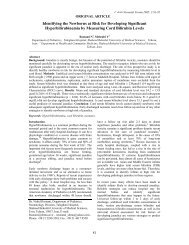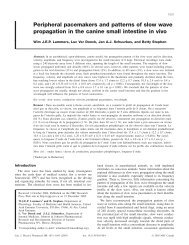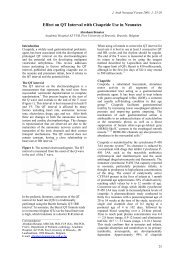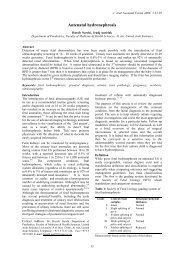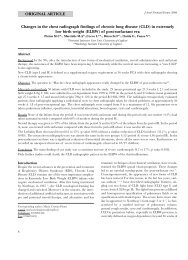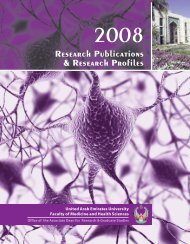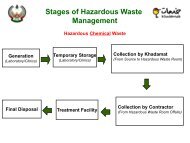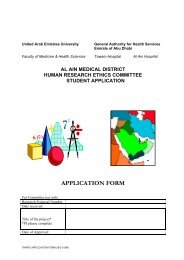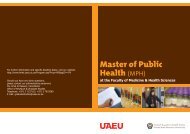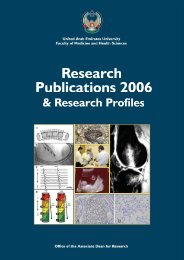Community Medicine Abstracts - College of Medicine and Health ...
Community Medicine Abstracts - College of Medicine and Health ...
Community Medicine Abstracts - College of Medicine and Health ...
You also want an ePaper? Increase the reach of your titles
YUMPU automatically turns print PDFs into web optimized ePapers that Google loves.
Project No. 250 (2009)Knowledge, attitude <strong>and</strong> practice <strong>of</strong> car seat use among pregnant women inAl Ain city: a cross-sectional studyStudent Authors: Nuha Nasir Mohamed Al Zaabi, Shamsa Mohammad Abdulla AlSuwaidi, Iman Rashed Humaid Al ShamsiFaculty Supervisors: Dr. I Blair, Dr. M. Grivna, Dr. R. BernsenAbstract:Introduction: The leading cause <strong>of</strong> death for children younger than 14 years <strong>of</strong> age isvehicular injury world wide. 460 children up to 14 years <strong>of</strong> age were killed in car crashinjuries in the UAE in the last 6 years. A study done in USA found that child restraintreduces the death rates in car crashes by 71% among infants <strong>and</strong> 54% among youngchildren. The prevalence <strong>of</strong> child car restraints in Al Ain city in 2004 was only 7%according to a study done by medical students. There is no law in the UAE regardingthe use <strong>of</strong> child car seats, however, seating children under the age <strong>of</strong> ten in the frontseat <strong>of</strong> the car leads to a fine <strong>of</strong> Dhs 400 <strong>and</strong> four traffic points.Methods: The study was carried out in Tawam, Al Ain <strong>and</strong> Oasis Hospitals <strong>of</strong> Al AinCity, one <strong>of</strong> the main cities <strong>of</strong> the UAE with a population <strong>of</strong> 460,000.A sample <strong>of</strong> 223pregnant women visiting the obstetric outpatient clinics were included. A consentform <strong>and</strong> information sheets were provided before subjects completed a selfadministeredquestionnaire.Results: The mean age <strong>of</strong> the participants was 28.9. forty three percent (96) wereEmarati nationals. 65% <strong>of</strong> the participants have children <strong>of</strong> which 71% answered thattheir children travel in their husb<strong>and</strong>'s cars. Seventy three percent <strong>of</strong> women whohave children do not own a car seat. 78% <strong>of</strong> the participants had poor knowledge <strong>of</strong>car seats’ use, 20% had good knowledge, while only 2% had excellent knowledge.99% <strong>of</strong> the participants either agreed or strongly agreed that car seats use isimportant. 76% <strong>of</strong> the participants thought that the best policy to change the presentattitude towards the use <strong>of</strong> car seats is to educate the public regarding car seats use<strong>and</strong> 27% thought that the best policy is to enforce car seat use by law.Statistically significant associations were found between owning a car seat <strong>and</strong> themonthly income (p value0.04), achieving a high knowledge score (p value 0.001),travelling in the mother’s car (p value 0.001), <strong>and</strong> believing that car seat use isimportant (p value 0.006). We have also found a statistically significant associationbetween a high knowledge score <strong>and</strong> believing that car seat use is important (p value0.05).Conclusion: Our study highlighted the importance <strong>of</strong> establishing educationalcampaigns to raise awareness <strong>and</strong> increase the practice <strong>of</strong> car seat use. Although theresults showed poor practice among the pregnant women which can be attributed totheir poor knowledge, still they demonstrated excellent attitude. One <strong>of</strong> the majorcontributing factors <strong>of</strong> not having car seats was related to the family income, so werecommend providing good quality car seats in affordable prices.



